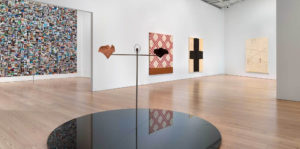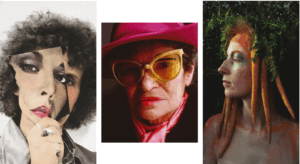
Whitney Biennial showcases Prof Emerita Hammond’s work
By: Michael Chesnick. May 14, 2024.Professor Emerita Harmony Hammond’s career continues to shine, 18 years after she retired from teaching at the University of Arizona School of Art.
She’s one of 71 artists participating in the prestigious 2024 Whitney Biennial, the longest-running survey of contemporary art in the United States, until Aug. 11 at the Whitney Museum of American Art in New York City.
For the Biennial’s 81st edition, titled “Even Better Than the Real Thing,” Hammond is presenting four paintings — including “Patched” (2022), a repurposed and mended quilt cover that foregrounds women’s time and labor. Her work reflects the exhibition’s theme that Artificial Intelligence (AI) is complicating our understanding of what is real.

“The surfaces are very organic, pieced and patched, mended and repaired, like our bodies — like my body,” said Hammond, who taught at the School of Art as a professor from 1989-2006.
School of Art Professor Paul Ivey nominated Hammond as a professor emerita in 2021.
“Harmony continues to inspire and lead the next generation of artists and feminist scholars,” Ivey said. “Though she may have retired from full-time teaching at the University of Arizona, she continues to be an active force in the feminist world, and has been for over six decades.”
Hammond created a queer feminist language of abstract art embedded in histories of sewing, weaving, quilting, making and the struggles of women. The artist, writer and independent curator’s groundbreaking book, “Lesbian Art in America: A Contemporary History (2000),” received a Lambda Literary Award and remains the primary text on the subject.
For the Whitney Biennial, her “Patched” painting features cotton squares stained with blood. They lie in the center of cross-like spaces formed by the quilt pattern. The reference the “repeated and ongoing violence against women, (including) the U.S. Supreme Court’s reversal of Roe v. Wade, and sexual brutality against women used as a weapon of war,” according to the Whitney website. A grid of grommeted holes below the quilt functions as a footnote, suggesting order but also bearing witness to the ongoing repetition of violence and healing.”
Also featured is Hammond’s “Chenille #11” (2020-2021), with “underlying colors of red and gold that split the seams and stain the thickly painted white burlap surface — evoking chenille bedspreads with its tufts and ridges. Grommeted straps bind the painting like bandages,” the Whitney website said. “Black Cross II” (2020-2021) and “Double Bandaged Quilt #3 (Vertical, 2020)” round out her exhibit.
“We see the seams in the painting. I do not like digital seamlessness,” Hammond said in a Whitney audio clip. “I like the seams to show. The seams show how things are connected. … That attachment thing, that idea of tying things together, of wrapping straps around a painting, could be thought of as restrictive binding, bandaging or bondage.”
Two years after earning her B.A. from the University of Minnesota in 1967, Hammond moved to New York, where she was a co-founder of A.I.R., the city’s first women’s cooperative art gallery and Heresies: A Feminist Publication on Art & Politics. In 1984, Hammond moved to New Mexico like her forbears, Georgia O’Keefe and Agnes Martin.
Hammond settled in Galisteo, New Mexico, and began commuting to Tucson and the University of Arizona in 1988 as a visiting instructor for the School of Art. She became a professor in 1989 and a tenured full professor in 1990, teaching painting, combined media and interdisciplinary graduate critique seminars until retiring in 2006.
“She was a warm, inspiring teacher,” Ivey said. “By example, she modeled positivity regarding the ambition one must have to be a successful artist and/or to bring art into their own teaching. To her students, she passed on her insights about creativity, perseverance and diligence.”
Living in two locations, Hammond unfolded a broader view of art to her students, Ivey said.
At the end of each semester, if she was assigned a graduate class — sometimes adding a few outstanding undergrads — she organized a trip to introduce them to several contemporary artists she knew in the Santa Fe area. Hammond also arranged introductions for the group to see museums and galleries in the area. Her plan included important art writers such as Lucy Lippard as well as exposure to specific gallerists and museum directors.
“While there, students were invited into her impressive studio, whereby she shared her own processes and multiple directions, and she arranged places for her students to stay, so they could take time to explore the area,” Ivey said. “During the weeks of teaching, she also set up studio in Tucson, in order to keep her ideas and work flowing, when she was fully present at her job in Tucson.”
Hammond also was responsible for bringing to campus now-famous artists and critics such as Nick Cave, Carrie Moyer, Judy Baca, Amy Silman and May Stevens.
While at the university, Hammond participated in 17 solo exhibitions, 86 groups exhibitions, including the important “High Times/Hard Times, New York Painting 1967-1975,” that traveled to Mexico and Europe.
Now 80, Hammond continues to focus on her art and occasionally attends environmental protests, women’s marches and pride parades. Since leaving the university, Hammond’s work has been exhibited in nearly 20 solo exhibitions and 70 group exhibitions. She considers exhibiting her art as one of her primary forms of activism.
“Exhibitions allow us to physically occupy space, so we are visible to queer and non-queer folks alike,” Hammond said in a 2019 ARTNews interview. “I’ve always been engaged with voices and forces that have been buried, or covered up, and assert themselves from underneath the surface of things.”

In 2019, the Aldrich Contemporary Art Museum in Ridgefield, Connecticut, organized a traveling solo exhibition along with a scholarly monograph, “Harmony Hammond: Material Witness, Five Decades of Art,” which featured Hammond’s “installational” and mixed-media paintings composed with vernacular materials she recovered from the Arizona and New Mexico landscape.
“The ruggedness of the land — its distinct cultural history and rural aesthetic — is evident in (Hammond’s) later work,” Hyperallergic wrote in a 2019 review of the solo exhibition, “accentuating it with a sense of place, and oddly enough, a new sense of belonging.”
While at the University of Arizona, Hammond received many important awards, grants and residencies, including a Pollock-Krasner Foundation Fellowship, a John Simon Guggenheim Memorial Foundation Fellowship, a Rockefeller Foundation Bellagio Study Center Residency in Italy, an Adolph and Esther Gottlieb Foundation Fellowship, a Joan Mitchell Foundation Grant, an Emily Harvey Foundation Residency in Venice, Italy, a College of Fine Arts Summer Research and Professional Development Incentive Grant, and also received a Veteran Feminist of America Award.
Since leaving the university, Hammond has received multiple prestigious awards, including induction in the National Academy of Design in New York, the Anonymous Was a Woman Distinguished Lifetime Achievement Award from the Women’s Caucus for Art, The College Art Association Distinguished Feminist Award, a Through the Flower Award for significant contributions to the Feminist Art Movement, and was named a National Women’s History Month Honoree.
Hammond’s work is represented by Alexander Gray Associates in New York City, where she has had six solo exhibitions. Hammond’s artwork has been collected by 50 important public museums, university museums, and corporations, including the Museum of Modern Art (New York).
According to Hammond’s website, “her earliest feminist work combined gender politics with post-minimal concerns of materials and process, frequently occupying a space between painting and sculpture – a focus that continues to this day.”
“Her near-monochrome paintings of the last two decades participate in the narrative of modernist abstraction at the same time they insist upon oppositional discourses of political content,” her website bio said. “Often referred to as social abstraction, the paintings which include rough burlap, straps, grommets, and rope, along with Hammonds signature layers of thick paint, engage formal strategies and material metaphors suggesting connection, restraint, agency and voice — a disruption of utopian egalitarian order, but also the possibility of holding together, of healing.”
Born in Chicago in 1944, Hammond studied art in Decatur, Illinois, before moving to Minneapolis with her husband, artist Stephen Clover, who came out as gay within a year of their marriage, Hyperallergic said. They moved to New York in August 1969, shortly following the Stonewall Riots.
“The city was a hotbed of political activity,” the 2019 Hyperallergic review said. “The Civil Rights movement, coupled with the women’s movement, antiwar protests, and the start of the Gay Liberation movement put New York on the cusp of a social and cultural revolution. Second-wave feminism was just around the corner. The couple separated, but Hammond was pregnant. She later gave birth to a daughter, Tanya.”
Hammond, who came out as a lesbian in 1973, was on the forefront of the feminist and lesbian art movement in New York in the early 1970s.
“It’s not only about making our work,” Hammond wrote in an Artsy post commemorating the 50th anniversary of Stonewall. “We also have to document and preserve it and insist on a place in history or it will be erased.”












